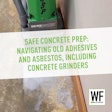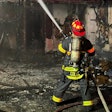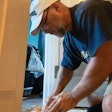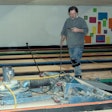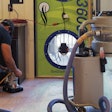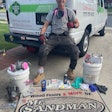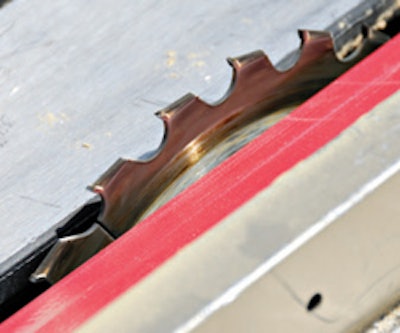
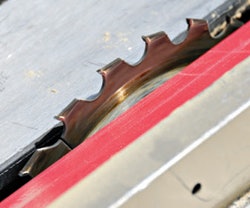
Hardwood flooring contractors don't have enough danger in their jobs to be featured in a TV show like "Deadliest Catch" or "Ax Men." But although they will never be fodder for reality TV, their jobs do involve plenty of hazards. Some are obvious (the table saw comes to mind), while others, like asbestos, may lurk silently.
The best protection against any hazard is awareness. Making safety a priority at your company, teaching employees about dangers and leading by example go a long way toward keeping everyone safe (and keeping your workers' comp premiums down, too—see "The Cost of Safety" in the December 2008/January 2009 issue). Fortunately, the days when it was considered macho to forego safety items like hearing, breathing and eye protection are long gone, and most contractors now take protecting their own health seriously. Following are 10 common safety hazards and how to prevent them.
1) Saw blades
The Danger: How many times have you heard a contractor tell this one: He'd been cutting boards for a big installation all day. He was tired, and as he was ripping the very last board, he got careless and sliced his hand on the table saw. Sadly, stories like this one are a dime a dozen in the wood flooring industry.
Prevention: Saws are dangerous, but take a few cues from contractors who still have all their digits intact. They usually don't…
- look away from what they're cutting
- use dull blades
- kneel directly behind the circular saw
- change blades without unplugging the saw
- use their fingers instead of a push stick on the table saw
- raise the table saw blade much higher than the material being cut (it should only be about 1/8 to 3/16 inch above the material)
- reach across the blade on the table saw to pull the board through
- get lazy, too comfortable or just complacent about how dangerous any saw can be.
2) Spontaneous Combustion
The Danger: Bags of wood dust or stain-soaked rags can both release heat, sometimes getting hot enough to ignite. Sometimes a spark from running over a nail can ignite the dust; dust containing old finish can be particularly dangerous. Unfortunately, it's incredibly common—most wood flooring contractors have either had a fire themselves or know another contractor who has.
Prevention: Never leave sanding bags or a vacuum containing wood dust sitting in a customer's house, your shop, or your van. One distributor tells of a customer who was pulled over because the bags in the back of his truck were going up in flames as he drove down the road (the contractor had no idea). Many contractors empty the bags into a dumpster or put the dust in garbage bags and put the bags on the curb; some contractors wet down the dust for good measure. If your workers put the bags on the curb, be sure the customer leaves them on the curb—homes have burned down because the homeowners put the bags next to the house to wait until garbage pickup day.
Common techniques for safely disposing of stainsoaked rags are to spread them out in a safe place (like a concrete driveway) to dry, sealing them into an empty finish can (they need oxygen to ignite), or, best of all, using a metal fireproof container designed for this purpose (your wood flooring distributor probably sells them).
3) Noise
The Danger: The joke is that a wood flooring contractor's answer to everything is "Huh?" Of course, there isn't really anything funny about hearing loss. Shortterm exposure to noise can make your ears feel stuffed up, or it can cause tinnitus (a temporary ringing in your ears). Long-term exposure to the noise of nailers, saws and sanding machines can cause permanent, incurable hearing loss or permanent tinnitus. Although there aren't specific statistics available for wood flooring contractors, according to the National Institute for Occupational Safety and Health, 44 percent of carpenters reported that they have perceived hearing loss, and the average 25-year-old carpenter has the hearing of someone who is 50 years old.
Prevention: There are many types of earplugs, as well as earmuffs (you can even get earmuffs that have a built-in radio). You might need to try several types of earplugs before you find some that fit correctly and comfortably. If you wear glasses, or if you have big sideburns or a heavy beard, you might not be able to get a good fit with earmuffs, so earplugs may be your only option.
4) Electricity
The Danger: Common sense tells us that electricity is nothing to mess around with—especially when it involves the 220 volts you need to run the big machine. Yet, some wood flooring contractors take chances with electricity every day. Hooking up 220 power by going directly to the leads in the box, cutting off grounds, using cords with nicks in them, hanging the cord around your neck while running the big machine, and using cords that are mostly electrical tape are just a few examples of everyday occurrences for some wood flooring crews. Yet, they're all risky. For example, contractors have been electrocuted when a nick in the cord made contact with their sweaty neck, and there are tragic stories about contractors who had the big machine cord hanging around their neck (in one case, the contractor ended up falling from a second-story loft because he was attached to his big machine with the cord around his neck). Other risks can exist through no fault of the contractors—some have been electrocuted when they walked into exposed wires sticking out of the floor or wall, not realizing the wires were hot.
Prevention: It may take a little more effort and planning to be safe with electricity, but it's worth it. Check for your power supply when you bid a job. If you don't have a 220-volt outlet to use, either learn the safe way to hook up power in the box (if you feel comfortable doing so and it's legal in your area), pay an electrician to do it or tell the homeowner they need to pay an electrician to install the necessary outlet. Don't think you can get your customer to agree to that? Many contractors do it every day. (For more on this, see the "Power Up" article in the June/July 2008 issue). Do the necessary maintenance on your machines, and replace your cords when they get damaged. (If you don't do this maintenance for safety's sake, do it for OSHA—OSHA inspectors can show up on one of your jobs at any time and hand you thousands of dollars of fines for unsafe practices). And, use a voltmeter to check any exposed wires on the job site.
5) Asbestos
The Danger: Until the 1970s, many building products, including some types of flooring, contained asbestos. Resilient floor tiles, including vinyl asbestos, asphalt and rubber tiles, often contained asbestos, as did some vinyl sheet flooring and adhesives used for installing floor tiles. When these products are sanded or otherwise disturbed, asbestos particles become airborne. Exposure can cause lung cancer and asbestosis, in which the lungs become scarred with fibrous tissue. The airborne particles are a threat not only to your workers, but also to the occupants of the home.
Prevention: There is no way to look at a product and know for certain if it has asbestos or not. The best bet is to leave it undisturbed or install over it—asbestos products are usually safe if they are intact and left alone. If you need to remove a product and you aren't sure it's new enough to be safe, have it tested (Google "asbestos test kit" to find many testing options). If it tests positive, have a professional specializing in asbestos removal handle it. Don't risk contaminating the home and opening yourself up to both a health hazard and liability.
6) Flying Objects
The Danger: You are ripping a board on the table saw, routing an area for an inlay or just shaving off that last bit on the chop saw, and a piece kicks up into your eye.
Prevention: Any time you're running a saw, a router, a sanding machine or you're nailing a floor, use safety glasses or other eye protection. It's also recommended any time you're pouring finish. Today's safety glasses are available in any style, so you won't look like that geek in chemistry class (not that wood flooring job sites are very fashion-conscious, anyway). And, you can even get standard safety bifocals or prescription safety glasses. Once you're in the habit of wearing safety glasses, you'll feel dangerously exposed without them.
7) Finish Vapors
The Danger: Finish vapors can be a threat in two ways: They can be dangerous when inhaled, and certain finishes have a low flash point—the lowest temperature at which a liquid produces enough vapor to catch fire in the presence of a flame or other ignition source. Lacquer, which is still commonly used in some areas of the country, especially the East Coast, has claimed the lives of wood flooring contractors when the entire job site has suddenly ignited.
Prevention: Always wear the recommended respirator when working with finishes (check the MSDS for that product to find out which type of respirator is recommended), and wear nitrile gloves when working with any finish. Waterborne finishes are generally considered safer than most other finishes, but it's best to err on the side of caution.
If you work with a finish with a low flash point (the flash point will be listed on the MSDS), you must eliminate any potential ignition source. This includes pilot lights (on stoves, water heaters, and clothes dryers, for example), and any cycling electrical appliances (such as refrigerators and air conditioners). Turn off power to the entire house, if possible, and have windows on the job site open until the finish is dry. The product vapors will tend to settle in areas like basements. And absolutely do not smoke on the job site.
8) Airborne Dust
The Danger: Read the MSDS for wood dust (did you know you are supposed to always have a MSDS for wood dust with you in your van?), and you'll find a long list under the "health hazard" section. Wood dust is a carcinogen and can cause asthma, nasal problems, coughing, wheezing, sinusitis, eye irritation and, depending on the species, "allergic contact dermatitis." Basically, no wood dust is good for you, but some species, especially many exotics, are known to cause stronger reactions in some people. The sensitivity also may build up over time—you may have worked with padauk for years, and then one day the skin on your arms breaks out after being covered in padauk dust.
Prevention: The better your dust containment system, the healthier your job site will be (as an added bonus, you can also see the floor better, leading to a better-quality job). Trailer-mounted systems are the most effective, but smaller systems also greatly reduce dust. At minimum, having your sanding equipment hooked up directly to vacuums makes the job site much more healthy (and pleasant). Regardless, always use a respirator designed to prevent wood dust, and fit it correctly—it doesn't do any good if it isn't fitted well.
Completely covering your skin while at a job site can help prevent dermatitis reactions, and showering as soon as possible after leaving the job site is a good idea. If you want to check if your skin will react to certain species, one method is to put the wood dust under a circular adhesive bandage on your arm and leave it in place for 24 hours.
9) Back and Knee Strain
The Danger: No two ways about it—being a wood flooring contractor is hard, physical labor, and backs and knees usually take the hardest hit. Carrying heavy sanding equipment, loading bundles of wood and constantly kneeling on the floor takes a continual toll on your body.
Prevention: You know the drill: wear your kneepads (there are tons of styles, so you should be able to find some that stay put and are comfortable). Lift with your legs, not your back. Whenever possible, minimize the load by taking the motor off the big machine when you have to transport it, or use a cart or some other transport system when you can. Also, take breaks throughout the day to stretch (for more on stretching and strengthening exercises for wood flooring contractors, see "Back in Business" in the October/November 2002 issue).
10) Lead
The Danger: Everyone knows that old paint may contain lead, but wood flooring finishes manufactured before 1978 also may contain lead, and the older the finish, the more lead it's likely to have. Sanding old finishes makes the lead airborne, creating a health risk for the contractors and the people who live there. Adults with lead poisoning may suffer from reproductive problems, high blood pressure and nerve disorders, among other problems, but it is even more damaging to children, who can suffer damage to the brain and nervous system, as well as other problems. Even a small amount of dust left on a windowsill, for example, could be dangerous to a toddler if the dust contains lead.
Prevention: Dust containment is crucial when sanding any finish that may contain lead. Use HEPA vacuums, and seal off the area to be sanded from the rest of the house. Protect HVAC vents to prevent contamination. Use a minimum of a NIOSH-approved half-mask respirator with a N95 filter designation. Wash your hands before eating or drinking, and change your clothes before going home.
The good news is that all 10 of the hazards on this list are largely avoidable—if you know what to do about them. Raising your own awareness and that of your employees will keep everyone out on the job site making money, instead of at home nursing an injury (or even worse).

It Seemed Safe
In this case, an experienced contractor didn’t worry about putting a backpack vac bag in the trash because there was only 1/8-inch of dust in it. It spontaneously combusted, however, melting the trash can and the adjacent exterior siding. Fortunately, the damage wasn’t worse.
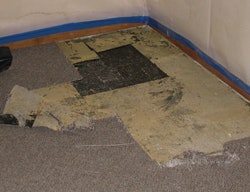

A Lurking Danger
Asbestos fibers look fluffy and harmless, just as some old asbestosladen floor coverings look harmless. Left alone, they usually aren’t a problem, but removing them can send the particles airborne, and a positive identification can only be done by testing. Pulling up this carpeting reveals a classic example of asbestos-containing vinyl tiles, which must be removed by a specialist.

Hot or Not?
Don’t make assumptions involving electricity—check all exposed wires for voltage. Sadly, some wood flooring contractors have been electrocuted by exposed wires that were supposed to be safe.

















